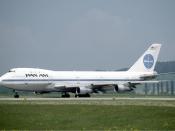Southwest Airlines has a history of being aggressive during tough times. The primary factors that have contributed to their success are: their on-time percentage and fast turnaround times; non-adaptation to the hub system operation; maintaining a fleet of exclusively 737 aircraft; short flights (typically 60 to 90 minutes long); and the "what ever it takes" prevalent in the corporate culture. Pre 9/11, Southwest was very successful in maintaining these strengths to grow and profit.
The post 9/11 strategy of Southwest should be to continue to differentiate itself through its focus on service, operations, cost control, marketing, its people, and its corporate culture, procedures, policies and growth models to maintain profitability. Southwest was the only major airline to maintain a full schedule, operating 100% of its aircraft, post 9/11. Further evidence of a successful formula is that the company also maintained full employment with no layoffs, furloughs, or unpaid leaves.
Continuation of growth while focusing on proven strategy of point-to-point operations is a key strategy. Southwest should have a primary focus on the 400-800 mile segment, this area is a better fit for growth since it is very consistent with current operations. They can expand to larger cities that operate similarly to existing cities within Southwest's network. Although inconsistent with the Southwest strategies they should begin adding some longer haul flights. These flights are a logical extension to the network with over 753 possible route segments in the 800-1200 mile range. Addition to the high traffic volumes these cities provide, they also allow access to larger base of airports or the network for the trafficking of longer flights.
Southwest can incorporate flights that originate or terminate at their present locations. The passengers can make direct flights to or from, or can use Southwest as a starting-point, mid-point, or end-point of...


